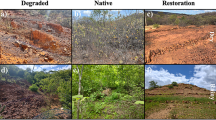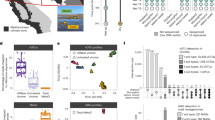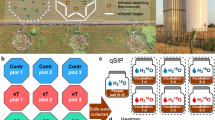Abstract
The microbial response to summer desiccation reflects adaptation strategies, setting the stage for a large rainfall-induced soil CO2 pulse upon rewetting, an important component of the ecosystem carbon budget. In three California annual grasslands, the present (DNA-based) and potentially active (RNA-based) soil bacterial and fungal communities were tracked over a summer season and in response to controlled rewetting of intact soil cores. Phylogenetic marker genes for bacterial (16S) and fungal (28S) RNA and DNA were sequenced, and the abundances of these genes and transcripts were measured. Although bacterial community composition differed among sites, all sites shared a similar response pattern of the present and potentially active bacterial community to dry-down and wet-up. In contrast, the fungal community was not detectably different among sites, and was largely unaffected by dry-down, showing marked resistance to dessication. The potentially active bacterial community changed significantly as summer dry-down progressed, then returned to pre-dry-down composition within several hours of rewetting, displaying spectacular resilience. Upon rewetting, transcript copies of bacterial rpoB genes increased consistently, reflecting rapid activity resumption. Acidobacteria and Actinobacteria were the most abundant phyla present and potentially active, and showed the largest changes in relative abundance. The relative increase (Actinobacteria) and decrease (Acidobacteria) with dry-down, and the reverse responses to rewetting reflected a differential response, which was conserved at the phylum level and consistent across sites. These contrasting desiccation-related bacterial life-strategies suggest that predicted changes in precipitation patterns may affect soil nutrient and carbon cycling by differentially impacting activity patterns of microbial communities.
Similar content being viewed by others
Log in or create a free account to read this content
Gain free access to this article, as well as selected content from this journal and more on nature.com
or
References
Alvarez HM, Silva RA, Cesari AC, Zamit AL, Peressutti SR, Reichelt R et al (2004). Physiological and morphological responses of the soil bacterium Rhodococcus opacus strain PD630 to water stress. FEMS Microbiol Ecol 50: 75–86.
Anderson MJ . (2001). A new method for non-parametric multivariate analysis of variance. Austral Ecol 26: 32–46.
Bates ST, Garcia-Pichel F . (2009). A culture-independent study of free-living fungi in biological soil crusts of the Colorado Plateau: their diversity and relative contribution to microbial biomass. Environ Microbiol 11: 56–67.
Birch HF . (1958). The effect of soil drying on humus decomposition and nitrogen availability. Plant Soil 10: 9–31.
Blazewicz S, Barnard RL, Daly RD, Firestone MK . (2013). Evaluating rRNA as an indicator of microbial activity in environmental communities: limitations and uses. ISME J; e-pub ahead of print 4 July 2013; doi: 10.1038/ismej.2013.102.
Borken W, Matzner E . (2009). Reappraisal of drying and wetting effects on C and N mineralization and fluxes in soils. Global Change Biol 15: 808–824.
Brodie E, Edwards S, Clipson N . (2002). Bacterial community dynamics across a floristic gradient in a temperate upland grassland ecosystem. Microb Ecol 44: 260–270.
Chang WS, van de Mortel M, Nielsen L, Nino de Guzman G, Li X, Halverson LJ . (2007). Alginate production by Pseudomonas putida creates a hydrated microenvironment and contributes to biofilm architecture and stress tolerance under water-limiting conditions. J Bacteriol 189: 8290–8299.
Clark JS, Campbell JH, Grizzle H, Acosta-Martinez V, Zak JC . (2009). Soil microbial community response to drought and precipitation variability in the Chihuahuan Desert. Microb Ecol 57: 248–260.
Cruz-Martinez K, Suttle KB, Brodie EL, Power ME, Andersen GL, Banfield JF . (2009). Despite strong seasonal responses, soil microbial consortia are more resilient to long-term changes in rainfall than overlying grassland. ISME J 3: 738–744.
de Boer W, Folman LB, Summerbell RC, Boddy L . (2005). Living in a fungal world: impact of fungi on soil bacterial niche development. FEMS Microbiol Rev 29: 795–811.
de Vries FT, Liiri ME, Bjornlund L, Bowker MA, Christensen S, Setala HM et al (2012). Land use alters the resistance and resilience of soil food webs to drought. Nature Climate Change 2: 276–280.
DeSantis TZ, Hugenholtz P, Keller K, Brodie EL, Larsen N, Piceno YM et al (2006). NAST: a multiple sequence alignment server for comparative analysis of 16S rRNA genes. Nucleic Acids Res 34: W394–W399.
Edgar RC . (2010). Search and clustering orders of magnitude faster than BLAST. Bioinformatics 26: 2460–2461.
Fierer N, Schimel JP . (2003). A proposed mechanism for the pulse in carbon dioxide production commonly observed following the rapid rewetting of a dry soil. Soil Sci Soc Am J 67: 798–805.
Fierer N, Jackson JA, Vilgalys R, Jackson RB . (2005). Assessment of soil microbial community structure by use of taxon-specific quantitative PCR assays. Appl Environ Microbiol 71: 4117–4120.
Fierer N, Bradford MA, Jackson JA . (2007). Toward an ecological classification of soil bacteria. Ecology 88: 1354–1364.
Fierer N, Lauber CL, Ramirez KS, Zaneveld J, Bradford MA, Knight R . (2012). Comparative metagenomic, phylogenetic and physiological analyses of soil microbial communities across nitrogen gradients. ISME J 6: 1007–1017.
Gao B, Gupta RS . (2012). Phylogenetic framework and molecular signatures for the main clades of the phylum Actinobacteria. Microbiol Mol Biol Rev 76: 66–112.
Goodfellow M, Williams ST . (1983). Ecology of Actinomycetes. Annu Rev Microbiol 37: 189–216.
Gordon H, Haygarth PM, Bardgett RD . (2008). Drying and rewetting effects on soil microbial community composition and nutrient leaching. Soil Biol Biochem 40: 302–311.
Griffin DM . (1977). Water potential and wood-decay fungi. Annu Rev Phytopathol 15: 319–329.
Griffiths RI, Whiteley AS, O’Donnell AG, Bailey MJ . (2000). Rapid method for coextraction of DNA and RNA from natural environments for analysis of ribosomal DNA- and rRNA-based microbial community composition. Appl Environ Microbiol 66: 5488–5491.
Halverson LJ, Jones TM, Firestone MK . (2000). Release of intracellular solutes by four soil bacteria exposed to dilution stress. Soil Sci Soc Am J 64: 1630–1637.
Hamady M, Lozupone C, Knight R . (2010). Fast UniFrac: facilitating high-throughput phylogenetic analyses of microbial communities including analysis of pyrosequencing and PhyloChip data. ISME J 4: 17–27.
Holmes AJ, Bowyer J, Holley MP, O’Donoghue M, Montgomery M, Gillings R . (2000). Diverse, yet-to-be cultured members of the Rubrobacter subdivision of the Actinobacteria are widespread in Australian arid soils. FEMS Microbiol Ecol 33: 111–120.
Inglima I, Alberti G, Bertolini T, Vaccari FP, Gioli B, Miglietta F et al (2009). Precipitation pulses enhance respiration of Mediterranean ecosystems: the balance between organic and inorganic components of increased soil CO2 efflux. Global Change Biol 15: 1289–1301.
IPCC (2007). Climate Change 2007: Impacts, Adaptation and Vulnerability. Contribution of Working Group II to the Fourth Assessment Report of the Intergovernmental Panel on Climate Change. Cambridge University Press: Cambridge, UK.
Jarvis P, Rey A, Petsikos C, Wingate L, Rayment M, Pereira J et al (2007). Drying and wetting of Mediterranean soils stimulates decomposition and carbon dioxide emission: the ‘Birch effect’. Tree Physiol 27: 929–940.
Jones SE, Lennon JT . (2010). Dormancy contributes to the maintenance of microbial diversity. Proc Natl Acad Sci USA 107: 5881–5886.
Kemnitz D, Kolb S, Conrad R . (2005). Phenotypic characterization of Rice Cluster III archaea without prior isolation by applying quantitative polymerase chain reaction to an enrichment culture. Environ Microbiol 7: 553–565.
Kieft TE, Soroker E, Firestone MK . (1987). Microbial biomass response to a rapid increase in water potential when dry soil is wetted. Soil Biol Biochem 19: 119–126.
Kunin V, Hugenholtz P . (2010). PyroTagger: A fast, accurate pipeline for analysis of rRNA amplicon pyrosequence data. The Open Journal Article 1.
Langer U, Böhme L, Böhme F . (2004). Classification of soil microorganisms based on growth properties: a critical view of some commonly used terms. J Plant Nutr Soil Sci 167: 267–269.
Lennon JT, Aanderud ZT, Lehmkuhl BK, Schoolmaster DR . (2012). Mapping the niche space of soil microorganisms using taxonomy and traits. Ecology 93: 1867–1879.
MacArthur R, Wilson E . (1967) The Theory Of Island Biogeography. Princeton: NJ, USA.
Nemergut DR, Cleveland CC, Wieder WR, Washenberger CL, Townsend AR . (2010). Plot-scale manipulations of organic matter inputs to soils correlate with shifts in microbial community composition in a lowland tropical rain forest. Soil Biol Biochem 42: 2153–2160.
Parker SS, Schimel JP . (2011). Soil nitrogen availability and transformations differ between the summer and the growing season in a California grassland. Applied Soil Ecol 48: 185–192.
Philippot L, Andersson SGE, Battin TJ, Prosser JI, Schimel JP, Whitman WB et al (2010). The ecological coherence of high bacterial taxonomic ranks. Nat Rev Microbiol 8: 523–529.
Placella SA, Brodie EL, Firestone MK . (2012). Rainfall-induced carbon dioxide pulses result from sequential resuscitation of phylogenetically clustered microbial groups. Proc Natl Acad Sci USA 109: 10931–10936.
Potts M . (1994). Dessication tolerance of prokaryotes. Microbiol Rev 58: 755–805.
Price MN, Dehal PS, Arkin AP . (2009). FastTree: Computing large minimum-evolution trees with profiles instead of a distance matrix. Mol Biol Evol 26: 1641–1650.
Quaiser A, Ochsenreiter T, Lanz C, Schuster SC, Treusch AH, Eck J et al (2003). Acidobacteria form a coherent but highly diverse group within the bacteria domain: evidence from environmental genomics. Mol Microbiol 50: 563–575.
R Development Core Team (2012) R: A language and environment for statistical computing. Vienna: Austria, ISBN 3-900051-07-0, URL. http://www.R-project.org/.
Ramirez KS, Craine JM, Fierer N . (2012). Consistent effects of nitrogen amendments on soil microbial communities and processes across biomes. Global Change Biol 18: 1918–1927.
Roberson B, Firestone MK . (1992). Relationship between desiccation and exoplysaccharide production in a soil Pseudomonas sp. Appl Environ Microbiol 58: 1284–1291.
Schimel J, Balser TC, Wallenstein MD . (2007). Microbial stress-response physiology and its implications for ecosystem function. Ecology 88: 1386–1394.
Schippers A, Neretin LN, Kallmeyer J, Ferdelmna TG, Cragg BA, Parkes RJ et al (2005). Prokaryotic cells of the deep sub-seafloor biosphere identified as living bacteria. Nature 433: 861–864.
Sheik CS, Beasley WH, Elshahed MS, Zhou X, Luo Y, Krumholz LR . (2011). Effect of warming and drought on grassland microbial communities. ISME J 5: 1692–1700.
Silkie SS, Nelson KL . (2009). Concentrations of host-specific and generic fecal markers measured by quantitative PCR in raw sewage and fresh animal feces. Water Res 43: 4860–4871.
Stark JM, Firestone MK . (1995). Mechanisms for soil moisture effects on activity of nitrifying bacteria. Appl Environ Microbiol 61: 218–221.
Swenson NG . (2009). Phylogenetic resolution and quantifying the phylogenetic diversity and dispersion of communities. PLoS ONE 4: e4390.
Tokunaga TK, Olson KR, Wan JM . (2003). Moisture characteristics of Hanford gravels: bulk, grain-surface, and intragranular components. Vadose Zone J 2: 322–329.
Vargas R, Collins SL, Thomey ML, Johnson JE, Brown RF, Natvig DO et al (2012). Precipitation variability and fire influence the temporal dynamics of soil CO2 efflux in an arid grassland. Global Change Biol 18: 1401–1411.
Waldrop MP, Firestone MK . (2006a). Response of microbial community composition and function to soil climate change. Microb Ecol 52: 716–724.
Waldrop MP, Firestone MK . (2006b). Seasonal dynamics of microbial community composition and function in oak canopy and open grassland soils. Microb Ecol 52: 470–479.
Ward NL, Challacombe JF, Janssen PH, Henrissat B, Coutinho PM, Wu M et al (2009). Three genomes from the phylum Acidobacteria provide insight into the lifestyles of these microorganisms in soils. Appl Environ Microbiol 75: 2046–2056.
Webb CO . (2000). Exploring the phylogenetic structure of ecological communities: An example for rain forest trees. Am Nat 156: 145–155.
Webb CO, Ackerly DDM,MA, Donoghue MJ . (2002). Phylogenies and community ecology. Annu Rev Ecol Syst 33: 475–505.
Winogradsky S . (1924). Sur la microflora autochtone de la terre arable. Comptes-rendus hebdomadaires des séances de l’Académie des Sciences (Paris) D178: 1236–1239.
Xu L, Baldocchi DD, Tang J . (2004). How soil moisture, rain pulses, and growth alter the response of ecosystem respiration to temperature. Global Biogeochem Cy 18: GB4002.
Zvyagintsev DG, Zenova GM, Doroshenko EA, Gryadunova AA, Gracheva TA, Sudnitsyn II . (2007). Actinomycete growth in conditions of low moisture. Biol Bull 34: 242–247.
Acknowledgements
We thank Maria Patanwala for nucleic acid extractions, James Cleaver for help in the field, Bob Keiffer, Valerie Eviner, Dustin Flavell, Becca Ryals, Kate McCurdy, Josh Schimel for access to the sites, Pascal Niklaus for statistical advice and Laurent Philippot for constructive comments on the manuscript. This work was funded by the Kearney Foundation of Soil Science. RB was funded by the European Community’s Seventh Framework Programme under grant agreement PIOF-GA-2008-219357.
Author information
Authors and Affiliations
Corresponding author
Additional information
Supplementary Information accompanies this paper on The ISME Journal website
Supplementary information
Rights and permissions
About this article
Cite this article
Barnard, R., Osborne, C. & Firestone, M. Responses of soil bacterial and fungal communities to extreme desiccation and rewetting. ISME J 7, 2229–2241 (2013). https://doi.org/10.1038/ismej.2013.104
Received:
Revised:
Accepted:
Published:
Issue date:
DOI: https://doi.org/10.1038/ismej.2013.104
Keywords
This article is cited by
-
Land management shapes drought responses of dominant soil microbial taxa across grasslands
Nature Communications (2024)
-
Enhanced biodegradable polyester film degradation in soil by sequential cooperation of yeast-derived esterase and microbial community
Environmental Science and Pollution Research (2024)
-
Effect of drought stress on symbiotic nitrogen fixation, soil nitrogen availability and soil microbial diversity in forage legumes
Plant and Soil (2024)
-
Changes in composition and function of soil microbial communities during secondary succession in oldfields on the Tibetan Plateau
Plant and Soil (2024)
-
Plant–plant and plant–soil interactions under drought and the presence of invasive buffelgrass (Cenchrus ciliaris)
Biological Invasions (2024)



